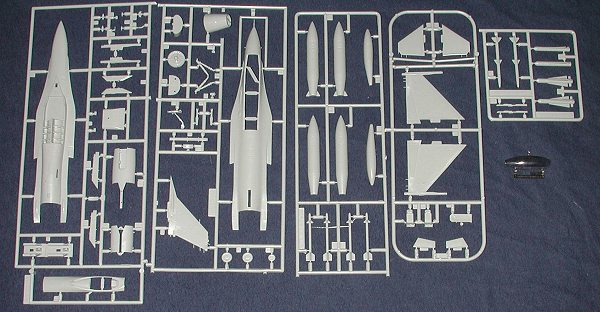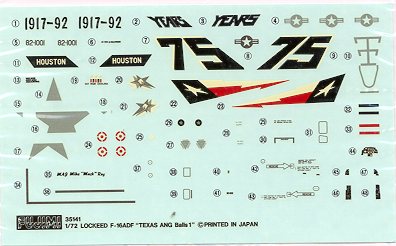
|
KIT: |
Fujimi 1/72 F-16A ADF |
|
KIT # |
35141 |
|
PRICE: |
$@20.00 |
|
DECALS: |
111 FIS, Texas ANG |
|
REVIEWER: |
|
|
NOTES: |

|
HISTORY |
Back around 1982 it was recognized that the US was soon to be sorely lacking in dedicated Air Defense aircraft. With the F-106 about to retire and the loss of the F-4D from the inventory as well, it was decided to modify the F-16 to undertake this mission. Most of the aircraft chosen were from the 80-/81-/82- serial range and eventually 273 aircraft were targeted for conversion, all of these being F-16A block15 aircraft. Not all aircraft were fully converted, indeed, some may not have been converted at all. The conversion basically meant a new IFF system and the capability of carrying the Sparrow missile on underwing pylons. Because of the need to install more avionics gear, some aircraft components were moved to other locations and that is shown by the large bulge on the lower fin. The F-16B version of the ADF does not have this fin bulge. Other external clues to the mission were a spotlight on the port side nose and the inclusion of a bank of IFF antennas on the lower intake and right in front of the canopy.
Despite testing, there were problems with the modifications. One of the biggest was with the Sparrow missile. With such a large missile, there was an unexpected problem when only one missile was carried. It caused such an aerodynamic influence that the aircraft basically had to carry both or none. It meant that when firing the missile, both had to be launched at once. Not exactly the best option as it was really the primary offensive weapon. There were also some electronic glitches, but nothing compared to the situation with the Sparrows. Your author doesn't know if those concerns with the Sparrows were ever successfully overcome or not.
These aircraft were only issued to the ANG, who had taken over the air defense mission. Eventually, thirteen squadrons were fully equipped with the aircraft, with the 162nd FG having a few for the ANG test unit. Interestingly, two of them, the 169 FS, Illinois ANG and 198 FS, Puerto Rico ANG were not given the ADF mission and were dedicated mud movers, even though they were equipped with the ADF Falcon. Those two squadrons are now flying the C-130. Other ADF units transitioned out of the type with Montana and North Dakota among those who were the last to give up their ADF Falcons before moving on to the F-16C.
|
THE KIT |

As many of you are undoubtedly aware, Fujimi kits are not the easiest to come by in the US. I had to order mine from overseas. If you have ever built a Fujimi F-16, then you will not be surprised by this one at all. It is basically your standard F-16A+ kit with an ADF tail. Completely missing are the spotlight, and any hint of the Sparrow missiles. However, it does include the 'Road Warrior' IFF antenna suite. As such, it cannot be built as a proper F-16A ADF right from the box. However, if you have a spare set of Sparrows, you can fill in the outer AMRAAM missile rail holes and mount the missiles to the middle pylons. The missing spotlight can be replicated by drilling a small indentation and using an MV lens. Not exactly the most elegant solution, but if you want a full mod ADF, that is what you'll have to do as you won't get it from the box.
The rest of the Fujimi kit is pretty normal for what was produced about the same time that Hasegawa's kit came out. It is a 'multi-mode' kit in that the basic airframe can accommodate both the single and twin-seat arrangement as well as any upgrades (like to an ADF or C/D model). The detail level is about the same as with the Hasegawa kit, though not quite as crisply done. As with the Hase kit, the wings are single piece with the holes already drilled for pylons, so if you are not going to use some of them you'll need to break out the filler. You might also want to look into new missiles. As I mentioned before you need some Sparrows and while you are at it, a new set of Sidewinders would help as the kit ones are less than optimal. Put the Mavericks in the spares box.
 Instrument
panels are represented by decals, which is fine as you cannot open the cockpit.
The kit supplies a properly dark, but single piece canopy. Centerline and inner
wing pylon drop tanks are provided to busy things up. The instructions are quite
similar to that supplied in a Hasegawa kit. Paint references are to the Gunze
line as well, though FS numbers are provided where needed. Unlike most other
companies, Fujimi generally only offers one decal option with most of its kits.
Decals are for one 'Lockheed' F-16A ADF attached to the 111 FS, Texas ANG. It
portrays the 50th Anniversary of either the guard or the 111th. They are thick,
should work well, and the whites are ivory as are most 'house' decals from
Japanese companies. There are a number of aftermarket decals that have ADF units
portrayed on them should you be inclined to skip the kit ones. Only the one unit
is portrayed.
Instrument
panels are represented by decals, which is fine as you cannot open the cockpit.
The kit supplies a properly dark, but single piece canopy. Centerline and inner
wing pylon drop tanks are provided to busy things up. The instructions are quite
similar to that supplied in a Hasegawa kit. Paint references are to the Gunze
line as well, though FS numbers are provided where needed. Unlike most other
companies, Fujimi generally only offers one decal option with most of its kits.
Decals are for one 'Lockheed' F-16A ADF attached to the 111 FS, Texas ANG. It
portrays the 50th Anniversary of either the guard or the 111th. They are thick,
should work well, and the whites are ivory as are most 'house' decals from
Japanese companies. There are a number of aftermarket decals that have ADF units
portrayed on them should you be inclined to skip the kit ones. Only the one unit
is portrayed.
|
CONCLUSIONS |
Since I know of no aftermarket options to convert a Hasegawa or Revell F-16 to the ADF variety, this is really your only option. The kit does build into a nice model as I've done several Fujimi Falcons in the past. It is a kit that is not difficult to build and is one that I can recommend. The real problem here in the US is finding one.
|
REFERENCES |
If you would like your product reviewed fairly and fairly quickly by a site that has well over 175,000 visitors a month, please contact me or see other details in the Note to Contributors.